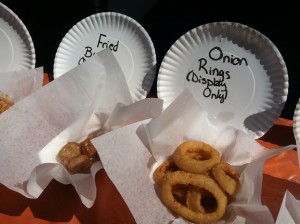 A few days ago I had the, ahem…pleasure of going to the grocery store with both my kids in tow. As any mom probably knows, I am using the word “pleasure” ironically. I know people with toddlers and preschoolers still have to do this, and I kind of enjoyed it when my kids were little enough to ride in the cart (Any outing was a good outing back then, right?). But since they’ve been ambulatory, my kids have rarely seen the inside of a grocery store. Here’s why: They see things they don’t normally get to eat. Things their friends bring in their lunchboxes. Or things of which mommy has denied the existence until now, such as Pop-Tarts and Wonder Bread. And the kids whine and beg. I knew I’d created a couple of monsters when my 8-year-old daughter held up a box of chocolate chip cookies, looked at me pleadingly, and said, “Mom, they’re organic so they’re healthy.”
A few days ago I had the, ahem…pleasure of going to the grocery store with both my kids in tow. As any mom probably knows, I am using the word “pleasure” ironically. I know people with toddlers and preschoolers still have to do this, and I kind of enjoyed it when my kids were little enough to ride in the cart (Any outing was a good outing back then, right?). But since they’ve been ambulatory, my kids have rarely seen the inside of a grocery store. Here’s why: They see things they don’t normally get to eat. Things their friends bring in their lunchboxes. Or things of which mommy has denied the existence until now, such as Pop-Tarts and Wonder Bread. And the kids whine and beg. I knew I’d created a couple of monsters when my 8-year-old daughter held up a box of chocolate chip cookies, looked at me pleadingly, and said, “Mom, they’re organic so they’re healthy.”
Now, where the heck did she learn that? Oops…guilty. While I still contend that organic chocolate chip cookies are better for you than Chips Ahoy (unfortunately), I do fully cop to being occasionally influenced by the “organic halo effect,” wherein we automatically think something is good for us just because it’s labeled “organic” — even if that something is loaded with sugar and processed white flour. “Better for you” doesn’t necessarily mean healthy.
Which brings me to the whole question of what actually is healthy eating? How do we define it? Obviously, that depends on who you ask. I’ll get very different answers if I ask a vegan friend and the Paleo guy at my gym. Some people adhere to strict low-fat or low-calorie diets. (I have a few friends who still guzzle diet soda and put artificially flavored nondairy creamer in their coffee.) And of course lots of folks are avoiding gluten and dairy these days. It seems very confusing, doesn’t it? Just thinking about all the mixed messages, nutritional information, supplements, scary health news, and dangers of this food and that food can cause enough stress to defeat the purpose of even attempting to eat healthily.
So, try not to think about all that stuff too much.
The simple way to eat healthy is simply to eat real food. It’s actually not all that confusing. I’m not a nutritionist, but I know enough to know that, with very few exceptions, the more processing, chemicals, artificial ingredients, genetic modifications, and refined sugar in a food, the worse that food will be for you. So, organic chocolate chip cookies might not contain genetically modified ingredients or icky chemicals, but there’s still plenty of processed white flour and sugar in them. They’re probably okay for a treat, as long as you keep one of Michael Pollan’s “food rules” in mind and “treat treats as treats.”
To define “real food,” I could write a list of what real food is and what it isn’t (IMO). Instead, here’s a distillation of Mr. Pollan’s real food manifesto from his best-selling books In Defense of Food and Food Rules. By the way, if you haven’t read those books, I can’t recommend them highly enough. Every time I pick one up, like I did just now, I am struck by how brilliantly simple, well-written, and convincing they are.
Pollan’s motto is, Eat food. Mostly plants. Not too much. The first part, “Eat food” means to eat real food — vegetables, fruits, whole grains, whole dairy products, and even fish and meat — and to avoid what Pollan calls “edible food-like substances,” which are highly processed, packaged, artificial, and unhealthy (those would be the things my kids beg for at the grocery store). In order to do that, Pollan offers super simple (although not always easy — believe me, I know) guidelines, or rules, for eating.
Here are a few:
- Don’t eat anything your great grandmother wouldn’t recognize as food. “When you pick up that box of portable yogurt tubes, or eat something with 15 ingredients you can’t pronounce, ask yourself, “What are those things doing there?” Pollan says.
- Don’t eat anything with more than five ingredients, or ingredients you can’t pronounce. Another way of saying this is, avoid food products that no ordinary human would keep in a pantry (i.e. xantham gum, high fructose corn syrup).
- Stay out of the middle of the supermarket; shop on the perimeter of the store. Real food tends to be on the outer edge of the store near the loading docks, where it can be replaced with fresh foods when it goes bad.
- Don’t eat anything that won’t eventually rot. There are exceptions (honey), but as a rule, Pollan says things like Twinkies that never go bad aren’t food (duh).
- Avoid food products that make health claims. In order for a food to make a health claim on its package, it must have a package, right? So it’s probably processed. Also, avoid foods with the words “lite,” “low-fat,” or “nonfat” in their names. People need fat, and when you remove the fat from something (by processing it), it usually contains more of something you don’t need, like sugar.
- Avoid foods you see advertised on TV. As a mom, this is one of my favorites. It immediately knocks candy, soda, and Doritos out of the shopping cart. No more fast food either.
- Don’t buy food where you buy your gas. In case you hadn’t noticed, they don’t sell much in the way of actual food at the Kum & Go.
And my personal favorite:
8. Beak the rules once in a while. So, go ahead and toss those organic chocolate chip cookies in the cart, just this once.
I’d be remiss if I didn’t remind you guys that I am now offering a meal-planning service! The REAL LIFE Meal Plan is up and running, and subscribers are loving how easy and fun it is to cook when your meals are all planned for you! For more info or to sign up, click here!
